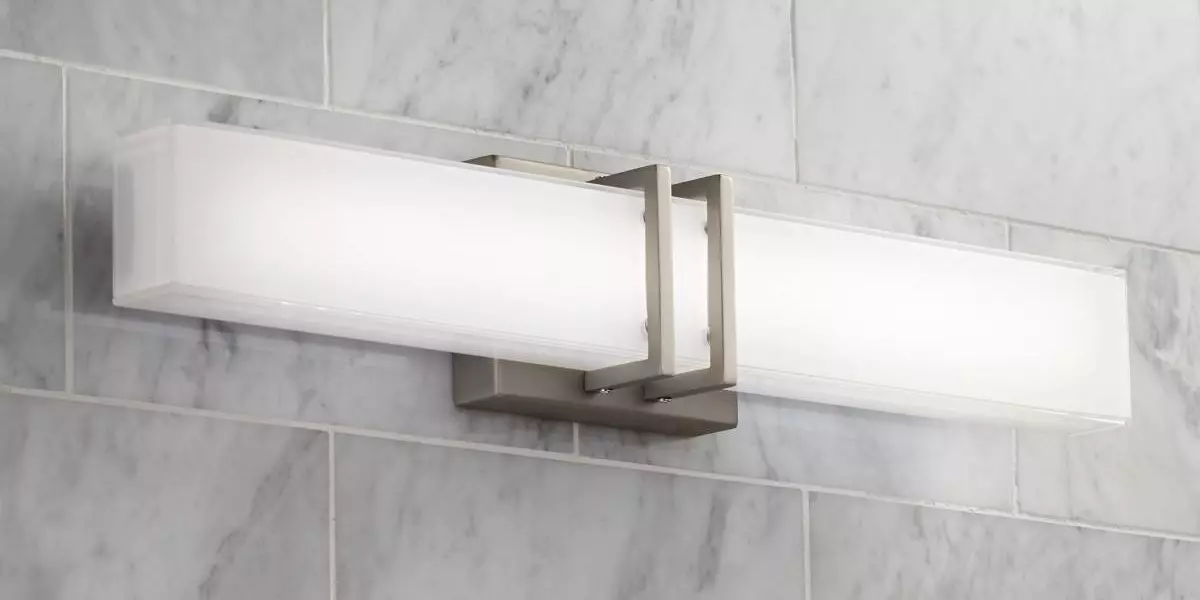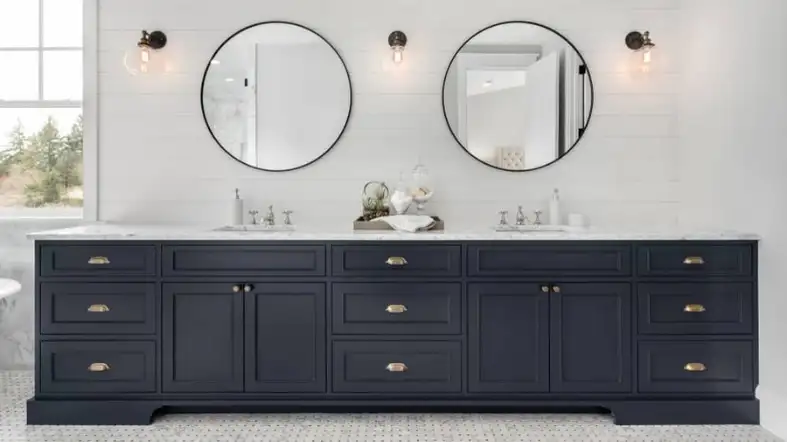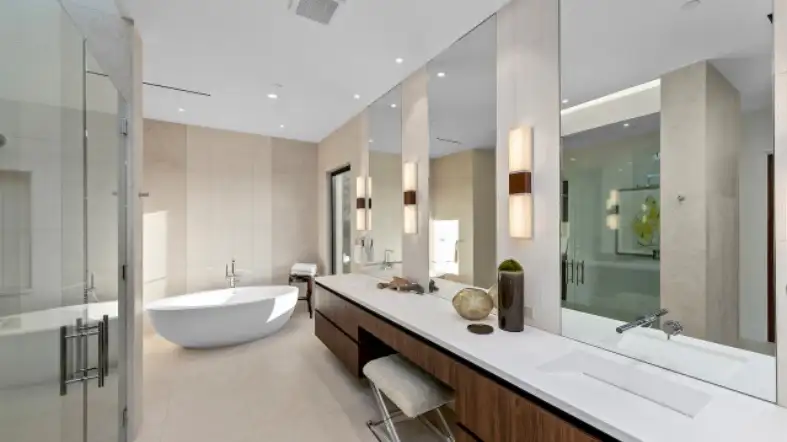Looking to revamp your bathroom and create the perfect vanity lighting? There is one crucial factor to consider is the width of the vanity light bar.
But how wide should the vanity light bar be? Finding the right balance between functionality and aesthetics is vital.
This article explores the ideal width for a vanity light bar, taking various factors into account.

How Wide Should a Vanity Light Bar Be?
If you choose to have one overhead vanity light, then a fixture measuring 32 inches (81.2 cm) wide would be perfect. The most suitable width for two overhead vanity lights would be 16 inches (40.6 cm) wide each. The vanity lights should be a third of the width of the full mirror.
Recommended Width of the Vanity Light Bar:
| Mirror Width | Recommended Vanity Light Bar Width |
|---|---|
| 24 inches | 18 inches |
| 30 inches | 22.5 inches |
| 36 inches | 27 inches |
| 42 inches | 31.5 inches |
| 48 inches | 36 inches |
| 60 inches | 45 inches |
| 72 inches | 54 inches |
Vanity Light Bar Width According to Different Vanity Sizes
For Small Vanities (24 inches and under)
Small vanities like those in powder rooms or half baths are typically 24 inches wide or less. For these small spaces, you’ll want to choose a vanity light that is proportional to the size of your vanity. A light bar that is too large will overwhelm the vanity.
- The ideal vanity light bar width for small vanities is between 12-18 inches wide. This will provide sufficient lighting coverage without appearing too large.
- Look for single bulb or 2-bulb fixtures in this size range. Mini sconces on each side of the mirror are also a great option.
- Make sure to center the light bar over the vanity to maximize light distribution. Measure the width of your vanity and choose a light that is at least 2/3 to 3/4 the total width.
For Medium Vanities (25 inches to 48 inches)
The standard size for a main bathroom vanity is commonly 25 to 48 inches wide. These medium sized vanities look best with light bars that are proportional in scale.
- For vanities 25-36 inches wide, choose a light bar that is 20-24 inches wide. The 30 inch size is ideal for centering over most standard 30 inch vanities.
- For vanities 37-48 inches wide, look for light bars in the 28-36 inch width range. A 32 or 34 inch bar nicely fits standard 60 inch vanities.
- Spacing is important – make sure the light bar does not exceed the edges of the mirror or vanity cabinet. Leave 3-4 inches on each side for proper fit.
- Multi-bulb fixtures with 3, 4 or 5 bulbs give the best illumination for medium vanity sizes. Go with a longer fixture to eliminate shadows.
For Large Vanities (49 inches and above)
Wider vanities call for wider light bars to ensure even lighting across the entire surface. Scale the light fixture to properly fit the larger vanity size.
- For vanities 49-60 inches wide, look for light bars in the 34-42 inch wide range. A 36 or 40 inch bar is ideal for even lighting.
- Extra wide vanities over 60 inches look best with even wider light bars in the 44-50 inch range. Make sure it doesn’t exceed the mirror/vanity width.
- 5-bulb light bars or linear fixtures provide the best illumination coverage for large vanities. Make sure to center the fixture over the vanity top.
- Watch out for light spillage on side walls or mirrors and adjust sconces if needed. Proper alignment over the vanity is key.
How to Choose the Right Vanity Light Bar Width?
To ensure you make the right decision, follow these steps:
Measure your Vanity Mirror
Begin by measuring the width of your vanity mirror using a tape measure. Take precise measurements to get an accurate understanding of the mirror’s size.
Calculate 75% of the Mirror Width
Multiply the mirror width by 0.75 to determine the recommended width for your light bar. This calculation is based on the general guideline.
It suggests the light bar should be approximately 75% of the mirror’s width.
Consider Space and Proportions
Consider your bathroom’s overall proportions and the available space around the mirror.
Choose a light bar width that harmonizes with the size and layout of the room. In a smaller bathroom, a narrower light bar may maintain a balanced aesthetic.
Balance with Vanity Size
Take into account the size of your vanity when selecting the light bar width.
A smaller vanity may call for a narrower light bar, while a larger vanity can accommodate a wider one.
Think about how the width of the light bar will complement the vanity’s dimensions.
Aim for Even Lighting
One of the primary purposes of a vanity light bar is to provide even illumination across the mirror surface.
Ensure that the chosen width allows for adequate lighting without creating shadows or dark spots.
This will ensure optimal visibility for grooming tasks, such as applying makeup or shaving.
Personal Preference
While there are guidelines to help you choose the right width, personal preference plays a significant role.
Consider your individual style, taste, and the overall aesthetic you want to achieve in your bathroom.
If you prefer a bolder, statement-making look, you might opt for a slightly wider light bar.
If you prefer a more minimalist or subtle approach, a narrower light bar might be more suitable.
What Types of Light Bulbs Are There?
There are many types of light bulbs to choose from. They are,
Incandescent Bulbs
The filament of an incandescent bulb heats up and glows when electricity passes through it.
They are the most common type of bulb but are less energy-efficient compared to other options.
Incandescent bulbs are being phased out in many countries due to their high energy consumption.
Halogen Bulbs
Similar to incandescent bulbs, halogen bulbs contain halogen gas to extend filament life.
Outdoor lighting, track lighting, and recessed fixtures use them to produce a bright, white light.
While halogen bulbs are more efficient than incandescent bulbs, they are still less efficient.
Compact Fluorescent Lamps (CFLs)
CFLs are energy-saving bulbs that use a fluorescent tube to produce light. They are more efficient than incandescent bulbs and last longer.
CFLs can be used in a variety of fixtures, including table lamps, ceiling fixtures, and recessed lighting.
They contain a small amount of mercury, so proper disposal is necessary.
Light Emitting Diodes (LEDs)
LEDs are highly energy-efficient and durable bulbs that use a semiconductor to produce light. They are versatile and come in various shapes and sizes.
Long lifespan and low energy consumption make LEDs popular in residential and commercial lighting.
They are available in different color temperatures, allowing for customized lighting options.
Smart Bulbs
Using a smartphone or other smart device, smart bulbs can be controlled remotely. They offer features like dimming, color-changing capabilities, and scheduling.
With smart bulbs, users can control lighting settings and create a personalized lighting experience.
Choosing the Right Bulb
Consider brightness, color temperature, lifespan, and energy efficiency when choosing a light bulb.
It’s also important to check the fixture compatibility and wattage requirements. You can make an informed decision by understanding the different bulb types and their features.

Common Mistakes to Avoid in Vanity Light Bar Width Selection
Avoid the following pitfalls:
Choosing an Inadequate Width
One common mistake is selecting a light bar that is too narrow for the vanity mirror. Grooming tasks can be difficult because of uneven lighting and shadows.
Opting for an Oversized Light Bar
Light bars that are excessively wide can overpower the space and create an unbalanced appearance.
It may also cause unnecessary glare or excessive brightness.
Ignoring Proportions
Failing to consider the proportions of the vanity and the bathroom as a whole is another mistake.
For a visually pleasing result, align the light bar’s width with the vanity’s size and the room’s dimensions.
Disregarding Personal Style
Neglecting your personal style and preferences can lead to dissatisfaction with the chosen light bar width.
Ensure the width of your bathroom aligns with the design theme and atmosphere you want to create.
Forgetting about Practicality
Remember that the purpose of a vanity light bar is to provide adequate illumination for grooming tasks.
Choosing a width that compromises lighting quality compromises functionality for aesthetics.
Overlooking Installation Requirements
Light bars may have specific installation requirements, such as mirror clearance.
Failure to account for these specifications can result in difficulties during installation or an improper fit.
Tips for Installing and Positioning Vanity Light Bars

Vanity light bars must be installed and positioned correctly to achieve optimal lighting. Follow these tips for a successful installation:
Choose the Right Height
When standing in front of the mirror, mount the light bar at a height that evenly illuminates the face.
A height of around 75-80 inches from the floor to the center of the light fixture is recommended.
Consider the Mirror Size
Take into account the size and width of the mirror when determining the placement of the light bar.
A light bar that extends beyond the mirror’s edges provides balanced lighting and prevents shadows.
Symmetrical Placement
For a visually pleasing look, aim for a symmetrical placement of the light bar. If you have a single light bar, position it in the center of the mirror.
When using multiple light bars or sconces, ensure they are evenly spaced on either side of the mirror.
Allow for Clearance
Ensure there is enough clearance between the light bar and the mirror when installing the light bar.
Follow the manufacturer’s guidelines regarding the recommended clearance distance.
Choose the Right Bulbs
Select bulbs with the appropriate wattage and color temperature to achieve the desired lighting effect.
Consider using LED bulbs for their energy efficiency and longevity.
Use Anchors for Stability
Ensure the light bar is securely attached to the wall by using appropriate anchors and screws. This will provide stability and prevent any accidents or damage.
Consult a Professional if Needed
If you’re uncertain about the electrical aspects of the installation or if it involves complex wiring, it’s advisable to consult a licensed electrician for safe and proper installation.
FAQs on How Wide Should Vanity Light Bar Be
Can I Use A Wider Light Bar For A Small Vanity?
When choosing the width of your light bar, however, you should maintain proportion and balance.
You may consider using a slightly narrower light bar to avoid overpowering the space.
Wider light bars are available for those who prefer a bolder statement.
The final decision depends on your personal taste and the overall aesthetic you want to achieve.
Should The Light Bar Be Wider Or Narrower Than The Mirror?
Ideally, the light bar should extend slightly beyond the edges of the vanity mirror.
It provides consistent illumination and prevents shadows on the mirror’s surface.
Light bars that extend slightly wider than mirrors provide a visually appealing lighting effect.
What Happens If The Light Bar Is Too Narrow?
Light bars that are too narrow for vanity mirrors can cause uneven lighting and shadows on your face.
The lack of light can make grooming tasks more challenging, such as applying makeup or shaving.
Choose a light bar width that provides adequate and even lighting across the mirror surface.
Will An Oversized Light Bar Overpower The Space?
Yes, using an oversized light bar can overpower the space and create an unbalanced aesthetic.
It may lead to excessive brightness, glare, or a disproportionate focal point.
Maintain a harmonious look by considering your vanity size and bathroom dimensions.
Choose a light bar that is proportionate to the vanity and the room’s layout.
Can I Customize The Light Bar Width?
Although there are general guidelines for light bar width, personal preference plays a significant role.
The light bar width can be customized based on your unique style, taste, and aesthetic.
If you have a narrow or wide light bar, you’ll need to strike a balance between functionality and design.
Final Words
Achieving the perfect vanity lighting is crucial for both functionality and aesthetics in your bathroom.
Light bars should be approximately 75% of the mirror’s width to ensure balanced lighting and eliminate shadows.
Don’t forget to measure your mirror, factor in the proportions, and choose the right width.
The right vanity light bar width enhances your daily grooming routines and elevates your bathroom ambiance.

